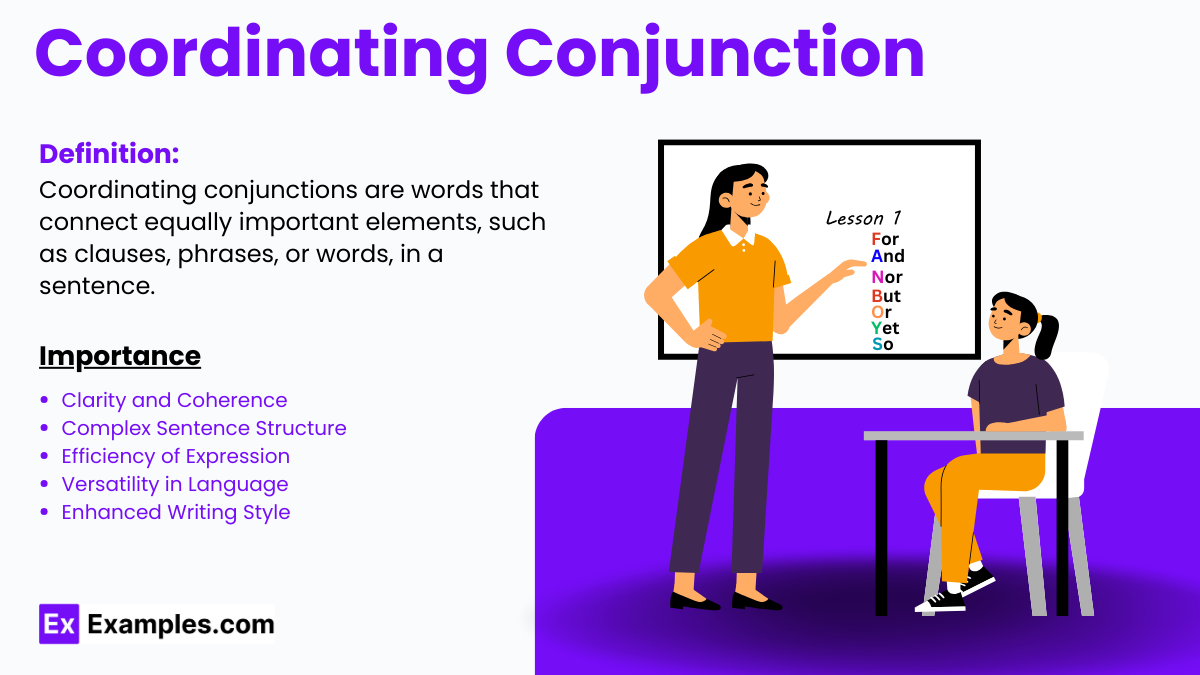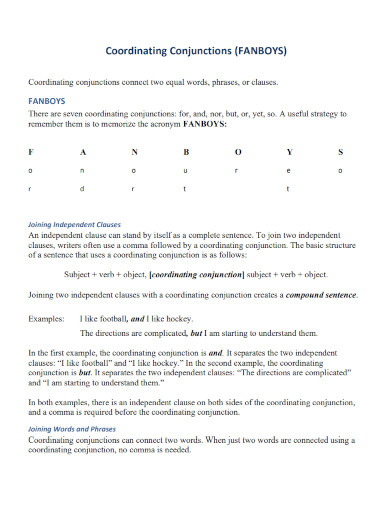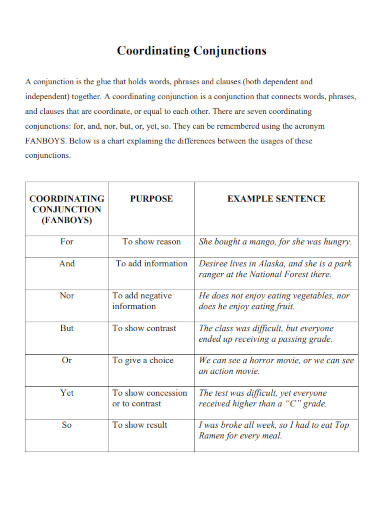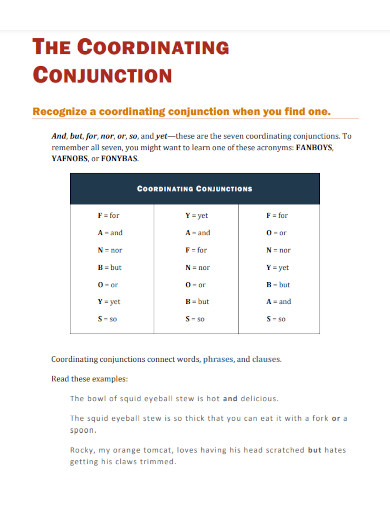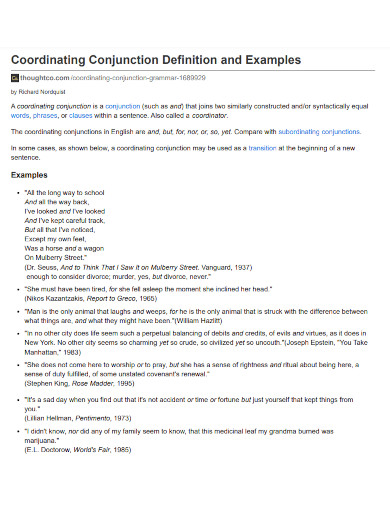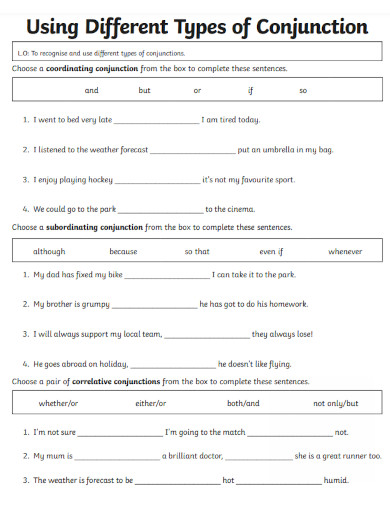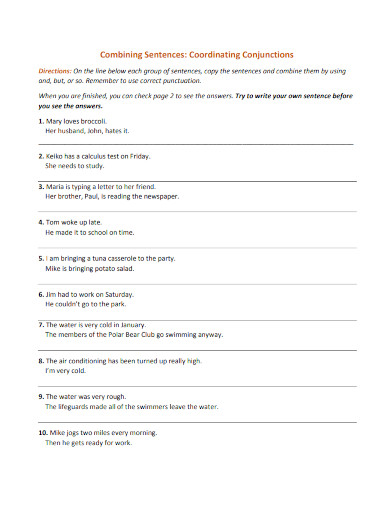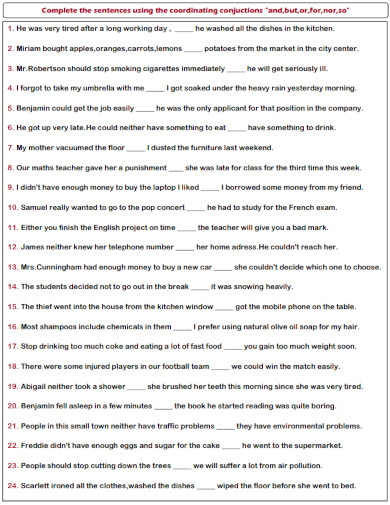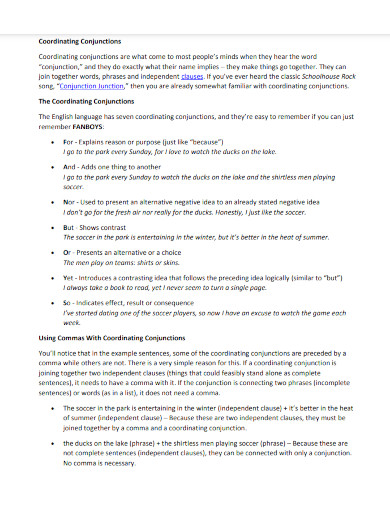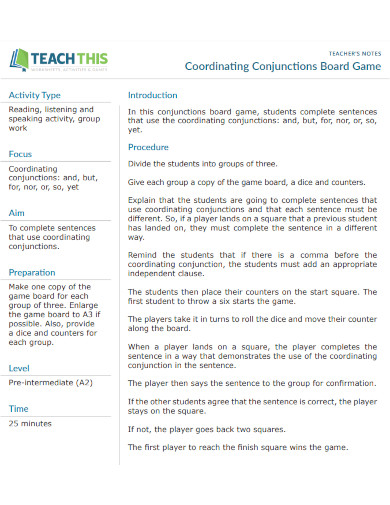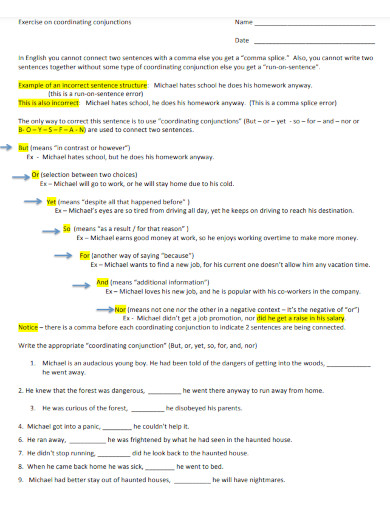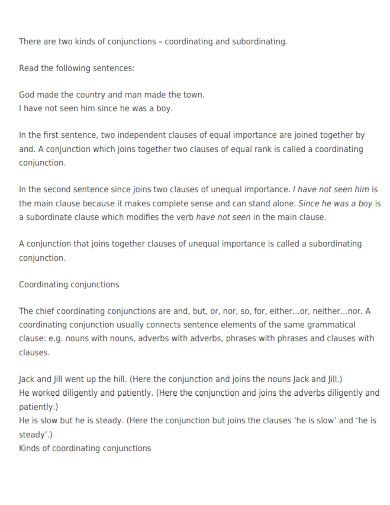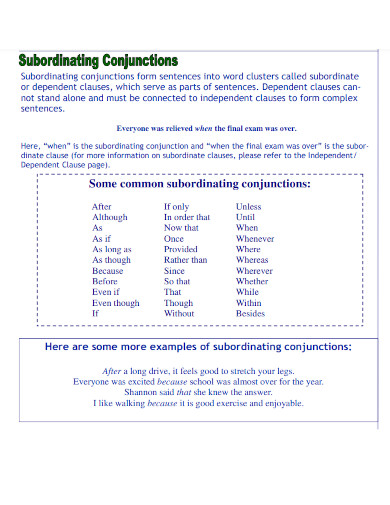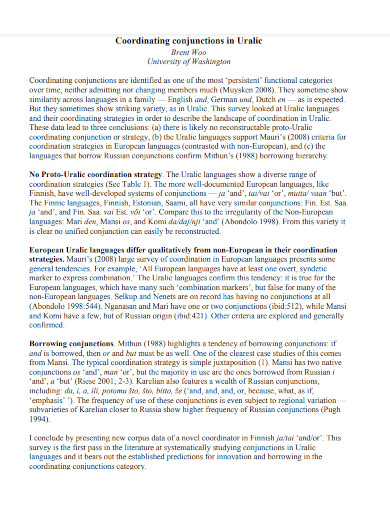20+ Coordinating Conjunction Examples
Coordinating conjunctions are essential components of English grammar, used to connect words, phrases, or clauses that are equally important within a sentence. The primary coordinating conjunctions are For, And, Nor, But, Or, Yet, and So, often remembered by the acronym FANBOYS. These conjunctions serve various functions: they add information (and), present alternatives (or), contrast ideas (but, yet), explain reasons (for), or connect cause and effect (so). Understanding how to use these conjunctions correctly allows for clearer and more effective communication, enhancing both writing and speech by creating complex, coherent sentences.
What is a Coordinating Conjunction?
Coordinating conjunctions are words that connect equally important elements in a sentence. The main ones are For, And, Nor, But, Or, Yet, and So (FANBOYS). They add information, present alternatives, contrast ideas, explain reasons, or establish cause and effect.
Importance of Coordinating Conjunction
Coordinating conjunctions are crucial in English language composition and communication. Their significance extends across several key areas:
- Clarity and Coherence: They help in constructing clear and coherent sentences that are easy to understand. By linking words, phrases, or clauses, coordinating conjunctions ensure that the ideas are logically connected.
- Complex Sentence Structure: These conjunctions allow the combination of multiple ideas in a single sentence without the repetition that would be necessary if the ideas were presented in separate sentences. This enables more sophisticated and varied sentence structures.
- Efficiency of Expression: Using coordinating conjunctions can make speech and writing more concise and impactful. They eliminate unnecessary verbosity, making communication more efficient.
- Versatility in Language: They add versatility to language use, enabling the speaker or writer to easily add contrast, choice, consequence, or reason within their statements, thus enhancing the expressiveness of the language.
- Enhanced Writing Style: Mastery of coordinating conjunctions can significantly improve a person’s writing style. The ability to effectively connect thoughts and ideas can make writing more engaging and persuasive.
List of Coordinating Conjunctions
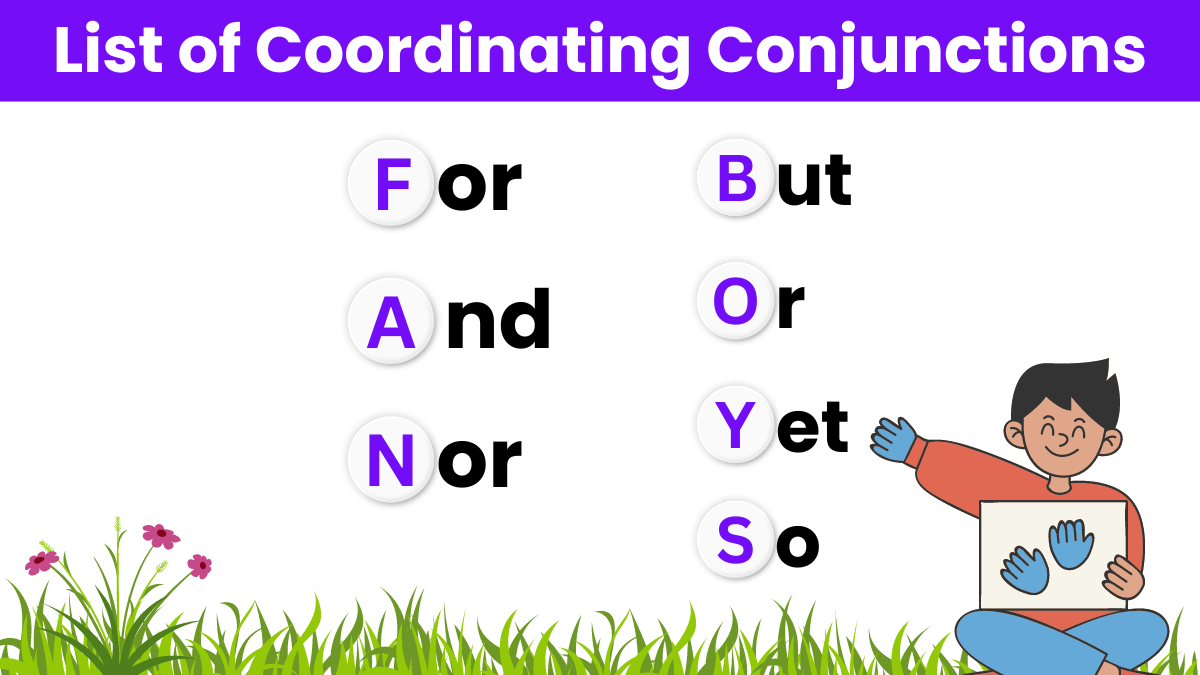
Coordinating conjunctions, often remembered by the acronym FANBOYS, include the following seven words, each serving distinct purposes in sentence construction:
- For – Indicates a reason or a purpose (similar to “because”).
- And – Adds one element to another, accumulating similar or related items or ideas.
- Nor – Adds a second negative element, often following “neither” or another negation.
- But – Introduces a contrast or an exception.
- Or – Offers a choice or alternative between two or more possibilities.
- Yet – Indicates a contrast or contradiction, often suggesting a surprising element.
- So – Implies a result or a consequence, linking cause and effect.
Coordinating Conjunctions to join Phrases
Coordinating conjunctions are highly effective for linking phrases in English, allowing for a smoother transition and logical connection between ideas. Here’s how to use each of the primary coordinating conjunctions (FANBOYS) for joining phrases:
- For: Used to explain a reason. Example: “She stayed up late for studying for her exam.”
- And: Connects additional or similar information. Example: “He likes reading mystery novels and watching detective shows.”
- Nor: Joins two negative phrases. Example: “She doesn’t like going out nor spending too much money.”
- But: Introduces a contrast. Example: “He wanted to go hiking, but the weather was too unpredictable.”
- Or: Offers choices or alternatives. Example: “You can have toast with butter or with jam.”
- Yet: Indicates a contrast, often surprising or unexpected. Example: “She is a novice at chess, yet she won a challenging game.”
- So: Shows a consequence or result. Example: “The roads were icy, so the school declared a delay.”
Coordinating Conjunction vs. Subordinating Conjunction
| Feature | Coordinating Conjunctions | Subordinating Conjunctions |
|---|---|---|
| Definition | Connects equal grammatical units within a sentence (words, phrases, or independent clauses). | Connects a dependent clause to an independent clause, indicating a relationship such as time, reason, condition, or concession. |
| Primary Examples | For, And, Nor, But, Or, Yet, So | Although, Because, If, Since, When, While, Unless |
| Usage | Used to add, contrast, choose, or explain within the same sentence. | Used to introduce a dependent clause and indicate its relationship to the main clause. |
| Placement in Sentence | Typically placed between the elements they connect. | Placed at the beginning of the dependent clause. |
| Punctuation | Often requires a comma before the conjunction when linking two independent clauses. | Typically does not require a comma when the dependent clause follows the independent clause, but does when it precedes it. |
| Effect on Sentence Structure | Creates compound sentences. | Creates complex sentences. |
| Example | “She bought apples and oranges.” | “She bought oranges because she likes citrus fruit.” |
Coordinating Conjunction Samples & Templates:
1. Coordinating Conjunctions Template
2. Coordinating Conjunctions Example
3. Recognize Coordinating Conjunction
4. Coordinating Conjunctions Worksheet
5. Coordinating Conjunction Definition
6. List of Subordinating Coordinating Conjunction
7. Different Types of Coordinating Conjunction
8. Coordinating Conjunctions Combining Sentences
9. Coordinating Conjunctions Exercises Worksheet
10. Sample Coordinating Conjunctions
11. Coordinating Conjunctions Board Game
12. Exercise on coordinating conjunctions Name
13. Coordinating Conjunctions
14. Some Common Subordinating Conjunctions
15. Coordinating Conjunctions in Uralic
Function of Coordinating Conjunction
Coordinating conjunctions play a pivotal role in English grammar by linking words, phrases, or independent clauses of equal grammatical importance. Here’s a breakdown of their primary functions:
- For: Introduces a reason or explanation. It often functions like “because.”
- And: Adds one element to another, combining them in a seamless way.
- Nor: Connects two negative alternatives, adding a second negative option.
- But: Indicates a contrast or exception between two elements.
- Or: Offers a choice or an alternative between two or more possibilities.
- Yet: Similar to “but,” it introduces a contrast that often follows an unexpected turn of events.
- So: Indicates a result or an effect, linking cause and consequence.
Rules of Coordinating Conjunction
Understanding and following the rules of coordinating conjunctions is essential for correct sentence construction in English. Here are the key guidelines:
- Equality and Balance: Coordinating conjunctions should only connect grammatical structures that are equal; for example, a noun with another noun, a clause with another clause, or a phrase with another phrase.
- Comma Usage:
- When connecting two independent clauses (complete sentences) with a coordinating conjunction, place a comma before the conjunction. Example: “I wanted to go for a walk, but it started raining.”
- No comma is necessary when the conjunction is linking shorter elements or phrases unless it helps avoid confusion.
- Avoid Overuse: While coordinating conjunctions are useful, overusing them can lead to choppy and simplistic sentence structures. Strive for a balance by combining complex and compound sentences in your writing.
- Parallel Structure: When elements are connected by coordinating conjunctions, maintain parallelism. This means that the elements should have the same grammatical form. Example: “She likes hiking, biking, and swimming.”
- Use of the Oxford Comma: In a series that lists more than two items, the Oxford comma (a comma before the final “and” or “or”) is optional but can often clarify the meaning. Example: “We bought apples, oranges, and pears.”
- Correct Conjunction Choice: Choose the correct conjunction to match the relationship you want to express between the clauses. Each of the FANBOYS (For, And, Nor, But, Or, Yet, So) has a specific function and adds a different meaning to the connections between ideas.
Examples of Coordinating Conjunction in Sentences
Here are examples of sentences using each of the coordinating conjunctions (FANBOYS), which include For, And, Nor, But, Or, Yet, So. These examples illustrate how these conjunctions connect words, phrases, and clauses within sentences:
- For: “He must hurry, for he is already late.”
- And: “She bought apples and oranges from the market.”
- Nor: “He could not find his keys, nor could he remember where he last saw them.”
- But: “She wanted to go to the movies, but it was too late.”
- Or: “Would you like tea or coffee?”
- Yet: “She was exhausted, yet she continued to work.”
- So: “It was raining, so they decided to stay indoors.”
- And: “They packed their bags and left before dawn.”
- But: “He likes to travel, but he hates flying.”
- Or: “Do you prefer chocolate or vanilla ice cream?”
- Nor: “She neither drinks nor smokes.”
- Yet: “He is young, yet he is very knowledgeable.”
- So: “The road was blocked, so they took an alternate route.”
- For: “We were hungry, for we had skipped breakfast.”
- And: “She studies hard and hopes to win a scholarship.”
How to Use Coordinating Conjunctions
Writers, researchers, and authors use coordinating conjunctions in their books (e.g. Any genres like biographies, autobiographies, and fiction), articles, letters, and research papers. (Both quantitative and qualitative papers) A properly placed and used coordinating conjunction can improve the text’s quality.
Step 1: Prepare the List of Coordinating Conjunctions
If you had not memorized the seven coordinating conjunctions, you must then prepare a list of all the coordinating conjunctions. This will allow you to have an easy-to-reach reference and outline, that you can use whenever you need it.
Step 2: Select The Two Phrases, Verbs, Or Clauses to Connect
After you have memorized or prepared the list of coordinating conjunction, you will then strategically select the two things you will connect using a coordinating conjunction. This will help you understand the nuance and the context of the sentence without sacrificing pacing and the theme. If you are connecting two clauses, ensure that both of the clauses are independent and can be read without the need for coordinating conjunction.
Step 3: Use the Correct Punctuation Points
Coordinating conjunctions might require the need for specific punctuation that comes before or after the coordinating conjunction. The punctuation point usually used to precede the coordinating clause is the comma (,) or the oxford comma, which can help improve the readability of the sentence.
Step 4: Repeat Steps Two and Three Until Finished
If you have finished with the steps above, you may repeat them as many times as needed. Just be sure to properly pace the amount of coordinating conjunctions or glue words to help with the readability. Too many of these words will negatively affect the overall flow and structure of the whole text.
What are coordinating conjunctions?
Coordinating conjunctions connect words, phrases, or clauses of equal importance. Common examples include “and,” “but,” “or,” “nor,” “for,” “so,” and “yet.”
How many coordinating conjunctions are there in English?
There are seven coordinating conjunctions in English: “and,” “but,” “or,” “nor,” “for,” “so,” and “yet.”
What is the function of “and”?
“And” adds or combines elements, showing that they are equally important or occur together. Example: “I bought apples and oranges.”
When do you use “but”?
“But” introduces a contrast or exception between two elements. Example: “She is talented but humble.”
How is “or” used in sentences?
“Or” presents alternatives or choices. Example: “Do you want tea or coffee?”
What does “nor” do in a sentence?
“Nor” is used to introduce an additional negative idea. Example: “He neither drinks nor smokes.”
How does “for” function as a conjunction?
“For” explains reasons or causes. Example: “She was tired, for she had worked all day.”
What is the purpose of “so”?
“So” shows a result or consequence. Example: “He studied hard, so he passed the exam.”
When should “yet” be used?
“Yet” introduces a contrast, often implying surprise. Example: “The weather was cold, yet they went swimming.”
Can coordinating conjunctions start a sentence?
Yes, starting a sentence with a coordinating conjunction can add emphasis or aid in smooth transitions, though it should be used sparingly.



